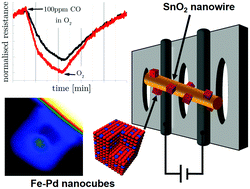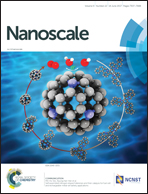In situ chemoresistive sensing in the environmental TEM: probing functional devices and their nanoscale morphology†
Abstract
In situ transmission electron microscopy provides exciting opportunities to address fundamental questions and technological aspects related to functional nanomaterials, including the structure–property relationships of miniaturized electronic devices. Herein, we report the in situ chemoresistive sensing in the environmental transmission electron microscope (TEM) with a single SnO2 nanowire device, studying the impact of surface functionalization with heterogeneous nanocatalysts. By detecting toxic carbon monoxide (CO) gas at ppm-level concentrations inside the microscope column, the sensing properties of a single SnO2 nanowire were characterized before and after decoration with hybrid Fe–Pd nanocubes. The structural changes of the supported nanoparticles induced by sensor operation were revealed, enabling direct correlation with CO sensing properties. Our novel approach is applicable for a broad range of functional nanomaterials and paves the way for future studies on the relationship between chemoresistive properties and nanoscale morphology.



 Please wait while we load your content...
Please wait while we load your content...